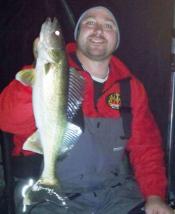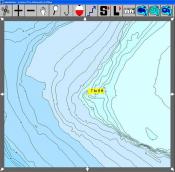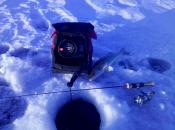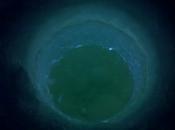 A recent thread here on In-Depth Outdoors posed a question regarding barometric pressure, and when the best time to fish is. Most agreed that pre-frontal conditions, especially when cloudy or during low light as the barometer is falling, spells the "perfect-storm" of fast and furious fishing. It would follow then, that some of the more undesirable times to fish would be directly after such an event. Specifically, a nasty cold high pressure front that settles over the area for a good period of time. Unfortunately, we can’t all be as lucky to choose exactly when we get to fish. Rather, often we have to be satisfied for the time off we do get and make the best of the situation. The trick then becomes working with the weather instead of making it an excuse.
A recent thread here on In-Depth Outdoors posed a question regarding barometric pressure, and when the best time to fish is. Most agreed that pre-frontal conditions, especially when cloudy or during low light as the barometer is falling, spells the "perfect-storm" of fast and furious fishing. It would follow then, that some of the more undesirable times to fish would be directly after such an event. Specifically, a nasty cold high pressure front that settles over the area for a good period of time. Unfortunately, we can’t all be as lucky to choose exactly when we get to fish. Rather, often we have to be satisfied for the time off we do get and make the best of the situation. The trick then becomes working with the weather instead of making it an excuse.
 So it was on Sunday afternoon, with the barometer on the rise, temperature falling, and wind whipping, the snowplow finally came past my place at 1pm. Fifteen minutes later I was headed north to take a short trip to fish a few low-light periods on a small walleye/perch lake. With winter water clarity typically being quite a bit better, the high skies and higher pressure, these short feeding windows were really what I was focusing on. Rather than expend energy and body heat in subzero temperatures on inactive fish in deep water, we chose to spend our prep time drilling and learning more about the lake rather than actually doing much fishing during the middle of the day. Not that we weren’t prepared…..my Otter Lodge was kept heated at all times and used as base camp for our drilling and fishing forays.
So it was on Sunday afternoon, with the barometer on the rise, temperature falling, and wind whipping, the snowplow finally came past my place at 1pm. Fifteen minutes later I was headed north to take a short trip to fish a few low-light periods on a small walleye/perch lake. With winter water clarity typically being quite a bit better, the high skies and higher pressure, these short feeding windows were really what I was focusing on. Rather than expend energy and body heat in subzero temperatures on inactive fish in deep water, we chose to spend our prep time drilling and learning more about the lake rather than actually doing much fishing during the middle of the day. Not that we weren’t prepared…..my Otter Lodge was kept heated at all times and used as base camp for our drilling and fishing forays.
 Both perch and eyes were found on classic near-shore and off-shore structure. Tips of humps with adjacent deep water, large rock-strewn points protruding from shore, etc. One trick was being there when the fish were, which was the last half hour of light and into the night. The next was coaxing them to eat our offerings. These fish were roaming and looking to eat, but beating them over the head with a large flashy spoon wasn’t effective. Small CJS slender spoons in more subdued colors were, specifically the black-nickel/chart. in 1/8th oz. After dark, in both shallow and deeper water, we relied on red glow lightning spoons, also in 1/8 oz. Bigger eyes fed during this period at dark and directly after, while the perch fed early and as shallow as 6-8 feet, being sure to clear out well in advance of the walleyes. Some of our best perch were actually on tip-up sets intended to fool last-light walleyes, with these perch hitting larger shiners and taking a good amount of line. While we never broke the 12" mark, there were many in the 11+" range that we were more than happy to catch. Hole hopping was most effective that last half hour for the eyes, and the temperatures made it challenging to say the least. That’s where the Snosuit shined. I was out with another friend who wore his cold-weather hunting garb, and was literally able to fish outside twice as long before my hands, not core temp, was finally intolerable. Needless to say, I drove the wheeler back to our destination each morning and night.
Both perch and eyes were found on classic near-shore and off-shore structure. Tips of humps with adjacent deep water, large rock-strewn points protruding from shore, etc. One trick was being there when the fish were, which was the last half hour of light and into the night. The next was coaxing them to eat our offerings. These fish were roaming and looking to eat, but beating them over the head with a large flashy spoon wasn’t effective. Small CJS slender spoons in more subdued colors were, specifically the black-nickel/chart. in 1/8th oz. After dark, in both shallow and deeper water, we relied on red glow lightning spoons, also in 1/8 oz. Bigger eyes fed during this period at dark and directly after, while the perch fed early and as shallow as 6-8 feet, being sure to clear out well in advance of the walleyes. Some of our best perch were actually on tip-up sets intended to fool last-light walleyes, with these perch hitting larger shiners and taking a good amount of line. While we never broke the 12" mark, there were many in the 11+" range that we were more than happy to catch. Hole hopping was most effective that last half hour for the eyes, and the temperatures made it challenging to say the least. That’s where the Snosuit shined. I was out with another friend who wore his cold-weather hunting garb, and was literally able to fish outside twice as long before my hands, not core temp, was finally intolerable. Needless to say, I drove the wheeler back to our destination each morning and night.
 In the process, I think I found what could be the best all-purpose rod I’ve ever fished. Earlier in the year, I had Lonnie at Thorne Brothers build a 32" Perch Sweetheart with titanium Recoil guides. My 28" perch sweetheart with outside guides was always a go-to in my arsenal, but especially for hole-hopping it’s nice to have a longer action for fighting fish, as well as standing to fish. However, for fishing inside of a house, anything in the 36" or greater range starts to get in the way of a hookset. That 32" rod is a sweet spot for me, and esp. in an Otter, I’ve got more than enough room, plus enough length when I go outside to fish and fight fish more comfortably. Some would argue that a perch rod doesn’t have enough backbone to drive a hook into a good ‘eye. I’d beg to differ. Not only did it have enough for that 24" fish, I drove it into the bony tip of that fish’s jaw. The longer action really cushions the large headshakes of a quality fish, and gives you a bit more security during the fight. While I wouldn’t fish this rod in deep water situations or anything 1/4oz or heavier, it fits the bill for the vast portion of winter fishing I do. The recoil guides have very little ice build-up issues, and when they eventually ice-in, a quick and not-very-gentle flick or twist clears them. That’s something you can’t do with a standard rod-guide. I worked that fish for over 3 minutes, and when it did gently take in just the minnow-tipped treble of the spoon, I was able to feel it like I was fishing braid in 5 FOW, even though I was using floro in 22FOW.
In the process, I think I found what could be the best all-purpose rod I’ve ever fished. Earlier in the year, I had Lonnie at Thorne Brothers build a 32" Perch Sweetheart with titanium Recoil guides. My 28" perch sweetheart with outside guides was always a go-to in my arsenal, but especially for hole-hopping it’s nice to have a longer action for fighting fish, as well as standing to fish. However, for fishing inside of a house, anything in the 36" or greater range starts to get in the way of a hookset. That 32" rod is a sweet spot for me, and esp. in an Otter, I’ve got more than enough room, plus enough length when I go outside to fish and fight fish more comfortably. Some would argue that a perch rod doesn’t have enough backbone to drive a hook into a good ‘eye. I’d beg to differ. Not only did it have enough for that 24" fish, I drove it into the bony tip of that fish’s jaw. The longer action really cushions the large headshakes of a quality fish, and gives you a bit more security during the fight. While I wouldn’t fish this rod in deep water situations or anything 1/4oz or heavier, it fits the bill for the vast portion of winter fishing I do. The recoil guides have very little ice build-up issues, and when they eventually ice-in, a quick and not-very-gentle flick or twist clears them. That’s something you can’t do with a standard rod-guide. I worked that fish for over 3 minutes, and when it did gently take in just the minnow-tipped treble of the spoon, I was able to feel it like I was fishing braid in 5 FOW, even though I was using floro in 22FOW.
Ultimately, it was a great trip to get the kinks out and feel what it’s like to set the hook on-ice again. Hopefully the snow continues to stay out of that portion of the state, as we had 4" of snow cover on the lake at most. Looking forward to another year!
Joel
Long shadows and low-light were key as illustrated in the first pic. Some good bonus perch greeted us wherever we went.
Joel
Nice work buddy! Any plans for a Perch fry??


Great report Joel

Way to stick with it and make it happen in some brutal cold weather

Awesome report Joel, and glad ya got on some fish! I never got a call so i figured you must be putting the hammer down on a few! lol. Those are some nice perch too, and a very nice eye! congrats!
Awesome report Joel, and glad ya got on some fish! I never got a call so i figured you must be putting the hammer down on a few! lol. Those are some nice perch too, and a very nice eye! congrats!
looks like a great time to me

Great report Joel
Looks like a great time Joel congrats and great read
Great report Joel!!
I’ll be on the ice for the first time this season this afternoon. I’ll be sure to keep your report in mind as we fish into the evening.
11+ inch perch are darn nice fish Joel!! I believe some of the best eating fish in the state. Very nice report, and I will have to agree with you on that 32 inch Perch Sweetheart. Can you breifly explain since I have regular guides on my TB rods your experience with your Titanium guides outside??
I’m pretty high on the recoil guides right now, so much so, that I’ll be moving over to using those exclusively in the next few years for all my thorne bros. rods. In all honesty, they don’t completely stop ice-up, but I’ve fished them thus far outside in -18 temps and had FAR fewer issues with ice-up. Rather than freezing over the tip fully, usually, the ice will form an icicle from water dripping off the bottom of the guide. The nicest part about these things is you can give them a quick twist and clear the ice. Be as aggressive or clumsy as you want within reason, these things spring back. Give standard guides a twist in the same way and you’ll break the rod or the guide.
My only gripe is that in extremely cold temps (< 0 deg. F), they don’t spring back very well and are a bit more malleable. It hasn’t been a hindrance whatsoever, and I’ll gladly deal with this to have literally half or less of the ice-up issues I’m used to with standard or even the alconite guides.
Joel
Joel, Thanks for the info on the guides. I am about to build a half dozen new rods for icing steelhead, browns , and eyes. I would assume they would hold up for this application? They look durable enough.
Randy:
I can only voice my opinion of their durability based on my experiences with the open-water St. Croix rods that have the same guides. I’ve literally only fished a total of 7 days on these, but everything I’ve seen has me wishing I had them on everything I own.
Particularly on this last trip to LOW, we fished outside almost exclusively. Even though the temps were as high as 25 degrees, snow and driving wind had my standard and alconite guides icing up quickly. The more you hole-hop, the worse it is, with every drop and reel-in bringing more water into the guides. The recoil guides simply make hole-hopping more of an option even in extremely cold temperatures. I like the fact that the limiting factor then is my ability to fight the cold rather than fighting my gear.
Joel
Good Information Joel!! I expect this is going initiate another online order for me from TB!!